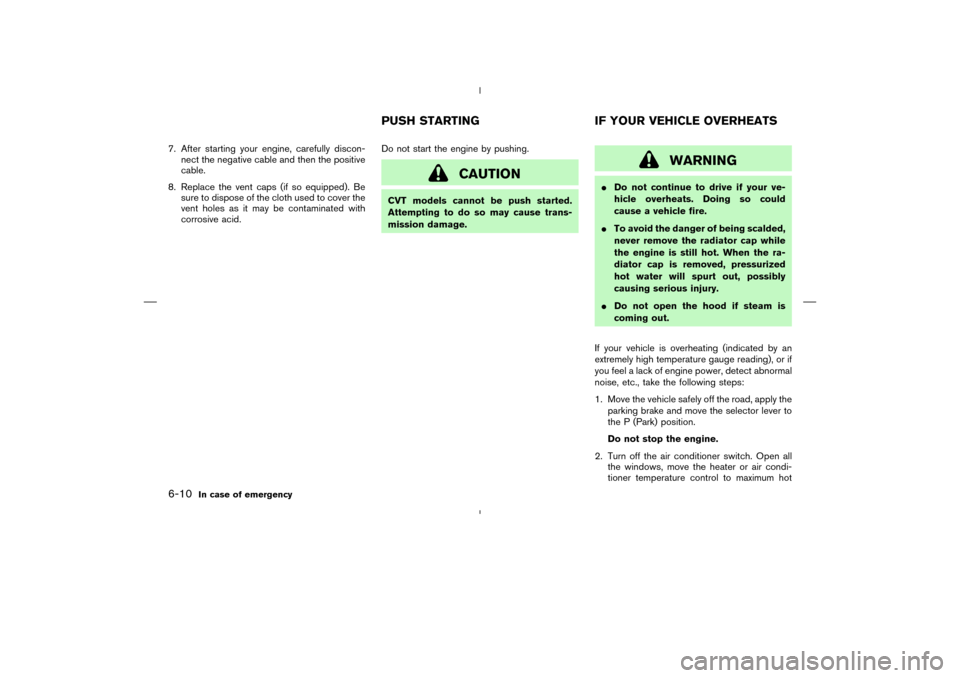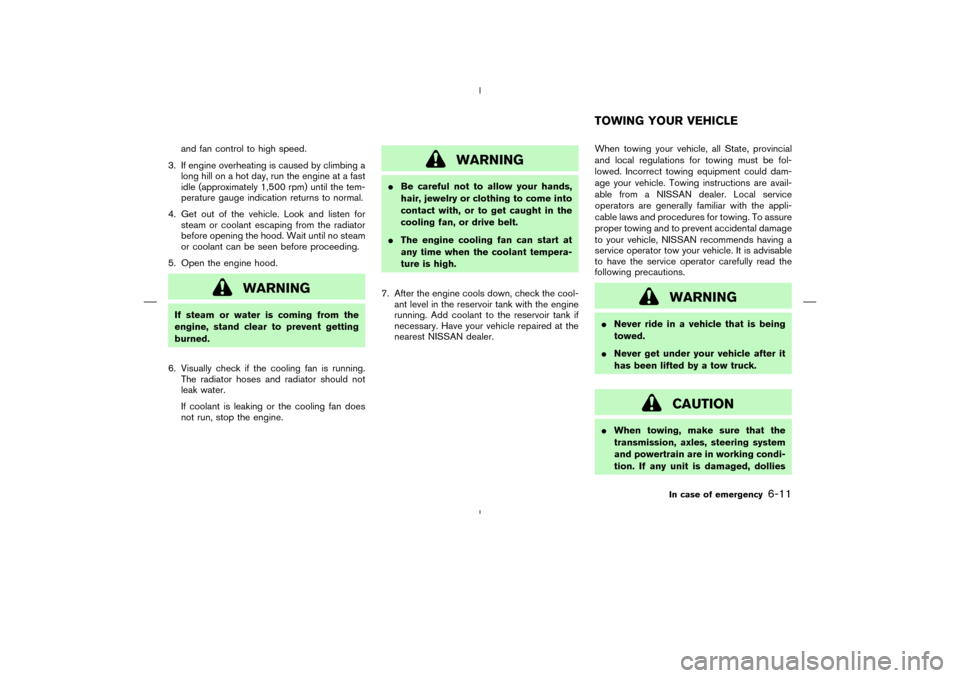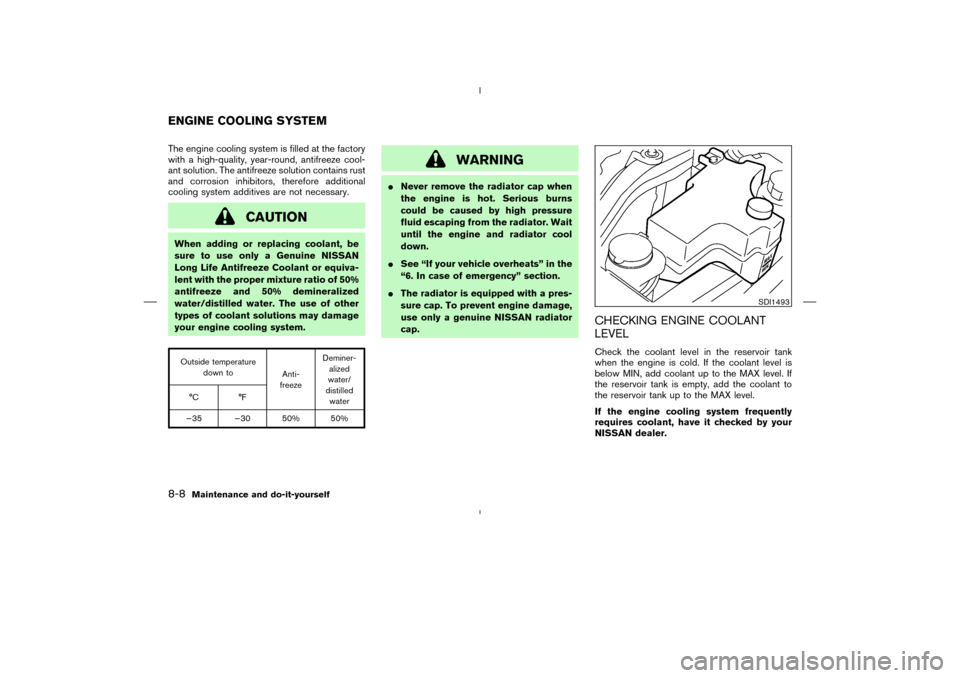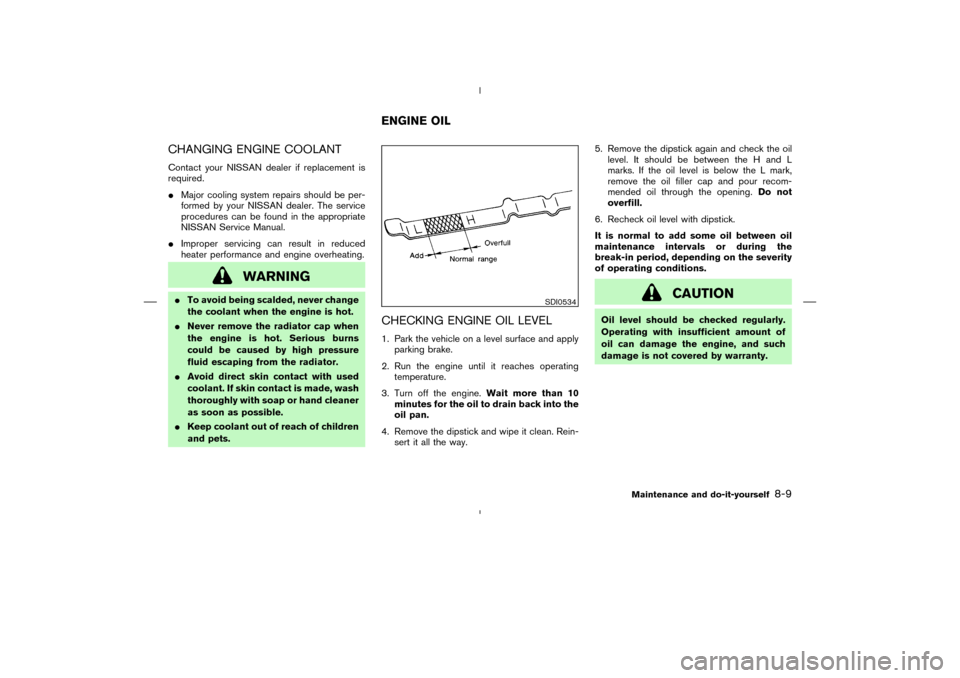Page 12 of 283
1. Power steering fluid reservoir (P.8-12)
2. Engine oil filler cap (P.8-10)
3. Brake fluid reservoir (P.8-12)
4. Air cleaner (P.8-16)
5. Windshield washer fluid reservoir (P.8-13)
6. Engine coolant reservoir (P.8-8)
7. Radiator filler cap (P.8-8)
8. Engine oil dipstick (P.8-9)
9. Fuse/fusible link holder (P.8-21)
10. Battery (P.8-14)
SDI1492
ENGINE COMPARTMENT CHECK
LOCATIONS
Illustrated table of contents
0-7
�
04.4.5/Z50-D/V5.0
�
Page 199 of 283

7. After starting your engine, carefully discon-
nect the negative cable and then the positive
cable.
8. Replace the vent caps (if so equipped). Be
sure to dispose of the cloth used to cover the
vent holes as it may be contaminated with
corrosive acid.Do not start the engine by pushing.
CAUTION
CVT models cannot be push started.
Attempting to do so may cause trans-
mission damage.
WARNING
�Do not continue to drive if your ve-
hicle overheats. Doing so could
cause a vehicle fire.
�To avoid the danger of being scalded,
never remove the radiator cap while
the engine is still hot. When the ra-
diator cap is removed, pressurized
hot water will spurt out, possibly
causing serious injury.
�Do not open the hood if steam is
coming out.
If your vehicle is overheating (indicated by an
extremely high temperature gauge reading), or if
you feel a lack of engine power, detect abnormal
noise, etc., take the following steps:
1. Move the vehicle safely off the road, apply the
parking brake and move the selector lever to
the P (Park) position.
Do not stop the engine.
2. Turn off the air conditioner switch. Open all
the windows, move the heater or air condi-
tioner temperature control to maximum hot
PUSH STARTING IF YOUR VEHICLE OVERHEATS
6-10
In case of emergency
�
04.4.5/Z50-D/V5.0
�
Page 200 of 283

and fan control to high speed.
3. If engine overheating is caused by climbing a
long hill on a hot day, run the engine at a fast
idle (approximately 1,500 rpm) until the tem-
perature gauge indication returns to normal.
4. Get out of the vehicle. Look and listen for
steam or coolant escaping from the radiator
before opening the hood. Wait until no steam
or coolant can be seen before proceeding.
5. Open the engine hood.
WARNING
If steam or water is coming from the
engine, stand clear to prevent getting
burned.
6. Visually check if the cooling fan is running.
The radiator hoses and radiator should not
leak water.
If coolant is leaking or the cooling fan does
not run, stop the engine.
WARNING
�Be careful not to allow your hands,
hair, jewelry or clothing to come into
contact with, or to get caught in the
cooling fan, or drive belt.
�The engine cooling fan can start at
any time when the coolant tempera-
ture is high.
7. After the engine cools down, check the cool-
ant level in the reservoir tank with the engine
running. Add coolant to the reservoir tank if
necessary. Have your vehicle repaired at the
nearest NISSAN dealer.When towing your vehicle, all State, provincial
and local regulations for towing must be fol-
lowed. Incorrect towing equipment could dam-
age your vehicle. Towing instructions are avail-
able from a NISSAN dealer. Local service
operators are generally familiar with the appli-
cable laws and procedures for towing. To assure
proper towing and to prevent accidental damage
to your vehicle, NISSAN recommends having a
service operator tow your vehicle. It is advisable
to have the service operator carefully read the
following precautions.
WARNING
�Never ride in a vehicle that is being
towed.
�Never get under your vehicle after it
has been lifted by a tow truck.
CAUTION
�When towing, make sure that the
transmission, axles, steering system
and powertrain are in working condi-
tion. If any unit is damaged, dolliesTOWING YOUR VEHICLE
In case of emergency
6-11
�
04.4.5/Z50-D/V5.0
�
Page 216 of 283
1. Power steering fluid reservoir
2. Engine oil filler cap
3. Brake fluid reservoir
4. Air cleaner
5. Windshield washer fluid reservoir
6. Engine coolant reservoir
7. Radiator filler cap
8. Engine oil dipstick
9. Fuse/fusible link holder
10. Battery
SDI1492
ENGINE COMPARTMENT CHECK
LOCATIONS
Maintenance and do-it-yourself
8-7
�
04.4.5/Z50-D/V5.0
�
Page 217 of 283

The engine cooling system is filled at the factory
with a high-quality, year-round, antifreeze cool-
ant solution. The antifreeze solution contains rust
and corrosion inhibitors, therefore additional
cooling system additives are not necessary.
CAUTION
When adding or replacing coolant, be
sure to use only a Genuine NISSAN
Long Life Antifreeze Coolant or equiva-
lent with the proper mixture ratio of 50%
antifreeze and 50% demineralized
water/distilled water. The use of other
types of coolant solutions may damage
your engine cooling system.Outside temperature
down to
Anti-
freezeDeminer-
alized
water/
distilled
water °C °F
−35 −30 50% 50%
WARNING
�Never remove the radiator cap when
the engine is hot. Serious burns
could be caused by high pressure
fluid escaping from the radiator. Wait
until the engine and radiator cool
down.
�See “If your vehicle overheats” in the
“6. In case of emergency” section.
�The radiator is equipped with a pres-
sure cap. To prevent engine damage,
use only a genuine NISSAN radiator
cap.
CHECKING ENGINE COOLANT
LEVELCheck the coolant level in the reservoir tank
when the engine is cold. If the coolant level is
below MIN, add coolant up to the MAX level. If
the reservoir tank is empty, add the coolant to
the reservoir tank up to the MAX level.
If the engine cooling system frequently
requires coolant, have it checked by your
NISSAN dealer.
SDI1493
ENGINE COOLING SYSTEM8-8
Maintenance and do-it-yourself
�
04.4.5/Z50-D/V5.0
�
Page 218 of 283

CHANGING ENGINE COOLANTContact your NISSAN dealer if replacement is
required.
�Major cooling system repairs should be per-
formed by your NISSAN dealer. The service
procedures can be found in the appropriate
NISSAN Service Manual.
�Improper servicing can result in reduced
heater performance and engine overheating.
WARNING
�To avoid being scalded, never change
the coolant when the engine is hot.
�Never remove the radiator cap when
the engine is hot. Serious burns
could be caused by high pressure
fluid escaping from the radiator.
�Avoid direct skin contact with used
coolant. If skin contact is made, wash
thoroughly with soap or hand cleaner
as soon as possible.
�Keep coolant out of reach of children
and pets.
CHECKING ENGINE OIL LEVEL1. Park the vehicle on a level surface and apply
parking brake.
2. Run the engine until it reaches operating
temperature.
3. Turn off the engine.Wait more than 10
minutes for the oil to drain back into the
oil pan.
4. Remove the dipstick and wipe it clean. Rein-
sert it all the way.5. Remove the dipstick again and check the oil
level. It should be between the H and L
marks. If the oil level is below the L mark,
remove the oil filler cap and pour recom-
mended oil through the opening.Do not
overfill.
6. Recheck oil level with dipstick.
It is normal to add some oil between oil
maintenance intervals or during the
break-in period, depending on the severity
of operating conditions.
CAUTION
Oil level should be checked regularly.
Operating with insufficient amount of
oil can damage the engine, and such
damage is not covered by warranty.
SDI0534
ENGINE OIL
Maintenance and do-it-yourself
8-9
�
04.4.5/Z50-D/V5.0
�